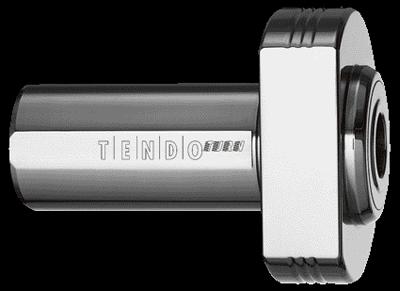
The Tendo-Tech is a line of special toolholders offered as standard from Schunk. These toolholders have technical features incorporated into the holder or are designed for a niche market or application, and are manufactured from the same high-grade tool steel as the company's Platinum line.
The TENDO-ES is short and rigid and the tool shank is clamped inside the machine spindle taper. It is excellent for low clearance situations and is the perfect combination with the SVL extension, which is quick and easy to change.
The TENDO-TURN is easy to change in turret mounted and CNC lathe applications. It is excellent for through-coolant drills and has added vibration dampening. The TENDO-RLA offers easy and accurate tool length presetting.
The TENDO-ZERO is the toolholder to use for ultimate control of runout for reaming and precision drilling.
All of the Tendo-Tech toolholders offer direct clamping diameters for the best precision, have a run-out of 0.003mm or less, have superior vibration dampening, and are repairable. They are available in CAT 40 and CAT 50 tapers and are sleeveable for added flexibility.
Contact Details
Related Glossary Terms
- clearance
clearance
Space provided behind a tool’s land or relief to prevent rubbing and subsequent premature deterioration of the tool. See land; relief.
- computer numerical control ( CNC)
computer numerical control ( CNC)
Microprocessor-based controller dedicated to a machine tool that permits the creation or modification of parts. Programmed numerical control activates the machine’s servos and spindle drives and controls the various machining operations. See DNC, direct numerical control; NC, numerical control.
- lathe
lathe
Turning machine capable of sawing, milling, grinding, gear-cutting, drilling, reaming, boring, threading, facing, chamfering, grooving, knurling, spinning, parting, necking, taper-cutting, and cam- and eccentric-cutting, as well as step- and straight-turning. Comes in a variety of forms, ranging from manual to semiautomatic to fully automatic, with major types being engine lathes, turning and contouring lathes, turret lathes and numerical-control lathes. The engine lathe consists of a headstock and spindle, tailstock, bed, carriage (complete with apron) and cross slides. Features include gear- (speed) and feed-selector levers, toolpost, compound rest, lead screw and reversing lead screw, threading dial and rapid-traverse lever. Special lathe types include through-the-spindle, camshaft and crankshaft, brake drum and rotor, spinning and gun-barrel machines. Toolroom and bench lathes are used for precision work; the former for tool-and-die work and similar tasks, the latter for small workpieces (instruments, watches), normally without a power feed. Models are typically designated according to their “swing,” or the largest-diameter workpiece that can be rotated; bed length, or the distance between centers; and horsepower generated. See turning machine.
- shank
shank
Main body of a tool; the portion of a drill or similar end-held tool that fits into a collet, chuck or similar mounting device.
- toolholder
toolholder
Secures a cutting tool during a machining operation. Basic types include block, cartridge, chuck, collet, fixed, modular, quick-change and rotating.

